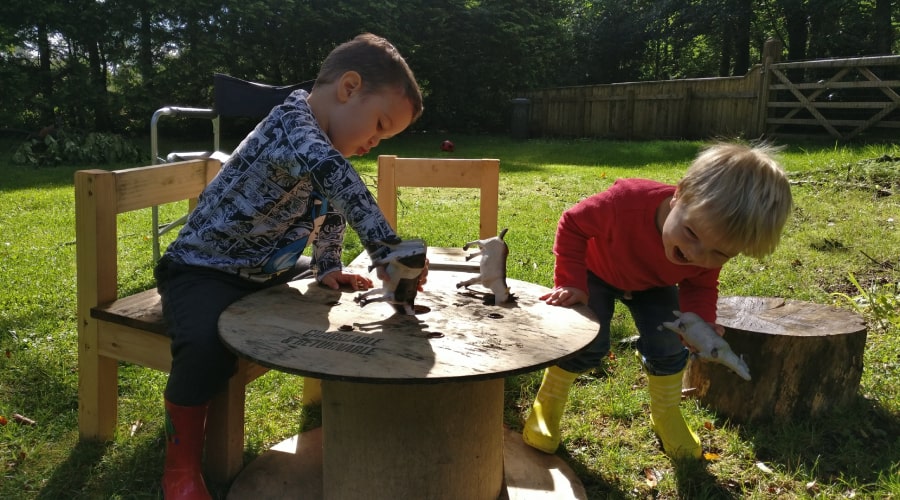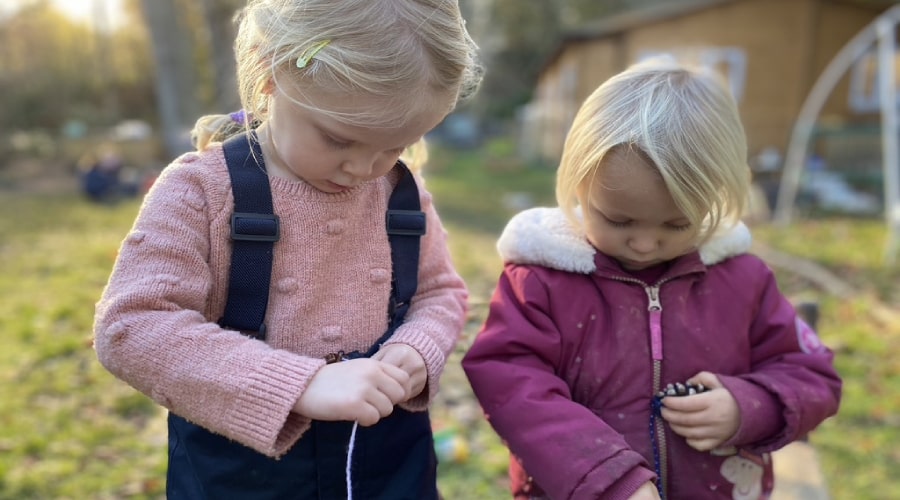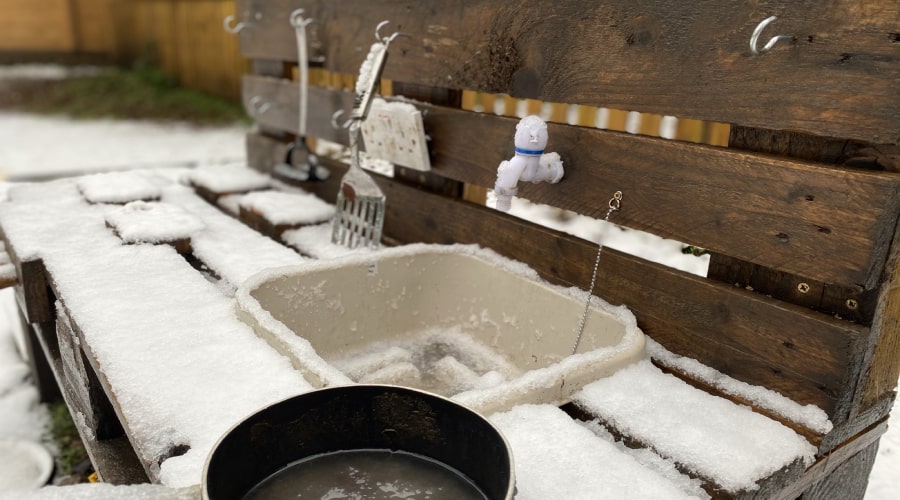Nursery School
New Brancepeth, Durham
2, 3, & 4 year old funding available
1
settings
20
children
With Famly since
June 2021
Cloth nappies are cool again.
Forget washing lines of grey terry cloth from your grandparents’ generation, cloth nappies are back and they’re colourful, practical, and of course, great for the environment.
When Hannah Dexter opened Deerness Valley Nursery School in March 2020, she and deputy head Jenny Morecroft decided they wanted to focus on having as little impact on the environment as possible, and make ethical choices where they could.
They get a weekly box of rejected ‘ugly’ fruit and veg, that would otherwise be thrown away, and plan the nursery meals based on what gets delivered. The setting has sustainable, wooden furniture and toys, as well as eco-friendly features in the building itself, such as excellent insulation, thermally efficient windows, and LED energy-saving light bulbs.
But the biggest key to Deerness Valley’s green mission might be their cloth nappies and reusable wipes.
“We’re a small nursery. We only have three spaces for under-twos, four spaces for two-year-olds, and thirteen spaces for over threes,” says Jenny, “But we go through twenty to thirty nappies a day. All of that would be going in landfill. And there’s no need.”
But what about all the laundry? Or worse, the leaks?
Never fear. Jenny and Hannah took time out to explain it all, including the bits you were afraid to ask.
Let’s get into it.
The big ideas
- Get the right equipment, including the…what?
The poo knife. Switching to cloth means you might need a few new tools, like the poo knife, as well as wet bags, and a nearby toilet. Don’t worry, we’ll come back to the poo knife. - Get the nappies right
Jenny recommends a cloth nappy that fastens with poppers, so you can adjust the size, and the style with a pocket for the lining, so that you can change the amount of padding for each child that uses it. - Get parents on board
The Deerness Valley team makes using cloth at nursery as easy for parents as possible, by making sure none of the laundry duty falls on families. - Get the children involved
As part of their practical curriculum, the children at Deerness Valley help to fold and store the clean nappies. This supports the children’s feeling of belonging, by contributing with meaningful work.
Get the right equipment
If you’re thinking of making the choice to switch to cloth nappies and reusable wipes, there are a few more things to consider than just the nappies themselves.
“We explored lots of different options as to how we could make [cloth nappies] work at nursery, and made tweaks as we went along, to make it run smoothly” explains Jenny
After some trial and improvement, here are the key elements that make their system work:
- Have your changing area with a toilet and a sink nearby.
You’ll need to empty the soiled nappies into the loo, and wet your reusable wipes under the tap. - Set up a storage solution for the soiled nappies.
Of course, you don’t just put them in the bin. The Deerness Valley team use a bucket with a lid for the emptied soiled nappies and ‘wet bags’ for the wet nappies. Wet bags are just water-proof bags with a zip, that go in the washing machine along with the nappies. - Work out the washing.
The washing machine the Deerness Valley team use is a WRAS category 5, that prevents the water in the machine from flowing back into the fresh water supply. Hannah explains that this is a legal requirement for them, as a business. However, although it’s considered an industrial machine, it’s barely bigger than a domestic one. The good news is, if you’re upgrading your setting’s washing machine, it’s a great time to switch to cloth nappies. And it needn’t cost a fortune. The Deerness Valley washing machine was pre-owned. Everything goes in on a long, 60º cycle, with a sluice, drain, and a rinse. - And the poo knife?
Well, sometimes you might need some help to empty a more heavily soiled nappy. The poo knife is just a dedicated palette knife to scrape more stubborn excretions into the toilet before you pop the nappy in the bucket to be washed.

Finding the nappy of your dreams
If you’re new to cloth nappies, all the choices can seem intimidating. So here are Jenny’s top tips for choosing the right ones:
- Find a friendly manufacturer
Jenny and Hannah chose Little Lamb nappies for Deerness, as they offered them a trade discount, to reduce up-front costs at the setting. Buying direct from the manufacturer means the nappies only cost them about £6 each and they can sell nappies through the nursery. - Choose the right fastening
Aim for nappies where the waterproof outer layer fastens with several rows of poppers, instead of velcro. Jenny advises that these last better, so you should be able to use and re-use your nappies for up to 4-5 years. It also means you can cut costs by purchasing fewer different sizes, as the poppers can be fastened on different rows, to make them smaller or larger. - Go for ‘pocket’ cloth nappies
These are nappies where, as the name suggests, the outer liner is effectively a large pocket. These work well for settings because you can adapt how absorbent the nappies are, by adding more of the lining into the pocket, for children who are heavier wetters. Staff have a list of which children need how much lining at their changing area. - Do the maths
Jenny says cloth nappies need to be changed every 2-3 hours (which is pretty standard for nappy changes at a nursery, anyway) but you can use this to calculate roughly how many nappies you’ll need. For example, at Deerness Valley they have roughly 10 nappies for each nappy-wearer they have on the register - 5 to wear and 5 in the wash. You can fit roughly 25 nappies in each wash, along with the wipes.
Once you’re happy with the brand you’ve chosen, the next step is to get the fit and lining right for each child.
Jenny shows new staff members where a cloth nappy should sit, as she explains they’re more like underwear than a disposable nappy. She advises that you might get a few leaks here and there, while you’re finding the best fit and absorbency for each child, so tells parents to bring a few extra changes of clothes, during the first week or so.

Get parents on board
The Deerness Valley team have used cloth since they opened, but if you’re thinking of making the switch at your setting, it makes sense to make the change really easy on your parents.
So how do they do it at Deerness Valley?
Hannah and Jenny wanted to make sure that their choice to use cloth nappies would be accessible for everyone joining the setting and wouldn't mean an extra cost for parents.
They also wanted the freedom to choose the nappies that would work best in a nursery setting.
“We asked ourselves how can we make that work for all of our children? So we decided that if we buy the nappies, they’re ours, so all the children can use them when they come to nursery.”
Hannah and Jenny also decided the setting would also take care of all of the laundry, so parents never have to do it. This means that the team know exactly how the nappies are being cleaned, so they’re confident that they’re always fresh, safe, and hygienic, ready for their next use.
The system they use at Deerness Valley is as follows:
- After their child’s last session of the week, the parents take home enough clean cloth nappies from nursery so that their child can arrive in a clean cloth nappy for each of their sessions the following week.
- Throughout the day, children are changed into clean nursery cloth nappies.
- For the last change of the day, children are changed into a ‘going home nappy’ that’s supplied by the parents. This can be a cloth nappy if that’s what the family use at home, or a disposable nappy.
This way, the children always go home in their own nappy, and all the used nursery cloth nappies go in the wash at nursery.
In fact, the team at Deerness Valley have got using cloth nappies down to such an art that they’ve inspired parents, who were previously using disposable nappies, to make the switch to cloth nappies at home.

Get the children involved
The curriculum at Deerness Valley is designed around meaningful work, as well as play. The children all share one room, from young babies to the pre-schoolers, as Hannah wanted the nursery to feel like a family.
And just like a family, that means doing a share of the work. Children help prepare meals, tidy up, and help with the clean laundry.
“Obviously, the children don’t touch the dirty nappies or load the washing machine,” explains Jenny, “That’s a grown-up job.”
But children do help with hanging out clean nappies, sorting them by size, and folding the clean cloth wipes. Jenny explains how this supports maths and fine motor skills, but also celebrates the contribution children can make to their peers and the setting.
“We’re a mixed-aged setting so the older children help the younger ones. Teaching responsibility and care is part of what we’re all about.”
On top of all of that, it means an adult isn’t tied up in the laundry room when they could be interacting with the children.

A re-use revolution
“There’s a lot of things in nursery education that people assume have to be done a certain way because that’s how they’ve always been done,” says Jenny.
But the team at Deerness Valley have shown that cloth nappies can work for a nursery setting.
Hannah’s top tip is to really focus on the fit.
“I’d only ever experienced disposable nappies so my first big learning was about how to fit them correctly. There’s more to think about [than with a disposable] leg tightness, liner not sticking out. But the children get used to the routine too and begin to cooperate with helping you check.”
The other side of that is working out what might have caused a nappy to leak.
“Learning why they’ve leaked has been really helpful. Did I fit it incorrectly? Did they have a big wee? These let you diagnose whether you need to take more care over the fit or ‘boost’ the nappy with more inside.”
However, Jenny warns, “It’s a bit of a ‘love’ - Once you use cloth nappies, you get a bit addicted to them! ”
Top tips from Alphabet House
Get top tips from a setting just like yours. Hear from Alphabet House on why and how they use Famly - and why they’ve never looked back.
Read their story










